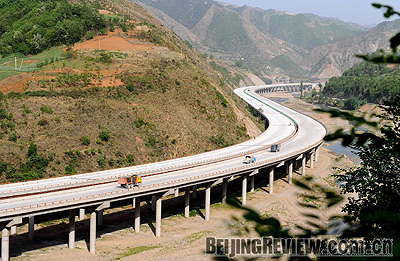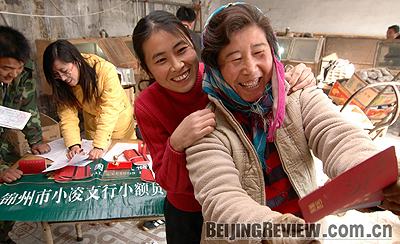|
|
 SUPPORTING FARMERS: The Postal Savings Bank of China issues small loans to local farmers in Liaoning Province, in keeping with the Central Government’s call to help boost rural income
SUPPORTING FARMERS: The Postal Savings Bank of China issues small loans to local farmers in Liaoning Province, in keeping with the Central Government’s call to help boost rural income |
The Central Government held its annual Central Economic Work Conference (CEWC) on December 8-10. In sharp contrast with previous conferences that focused on reining in the country's overheated economy, this year's CEWC established policies and guidelines to maintain China's sustainable economic growth in 2009 and prevent an economic downturn.
The CEWC, which China holds in December each year, aims to summarize the current year's economic development, propose economic development goals for the next year, set the tones for macroeconomic control policies, and deploy major economic missions for next year.
Sharp turn
Early this year, government decision makers were still anxious about the country's overheated economic development. "Preventing economic growth from transferring from relatively fast to overheated" and "preventing price surges in some sectors from growing into overall inflation" were among the major economic tasks they had set. They made this decision based on the country's trend of double-digit economic growth, excessive liquidity in the capital markets, and rising investment and consumer price index (CPI).
|

INVESTMENT IS KING: China plans to invest heavily in infrastructure and social welfare to fend off a possible economic downturn next year | Figures from the National Bureau of Statistics (NBS) showed China's GDP grew 11.4 percent last year, which was the fourth consecutive year that the country had maintained double-digit GDP growth. In 2007, aggregate fixed-asset investment across the country grew 24.8 percent, continuing the investment spree that started in 2003. Investment in real estate grew at an astonishing speed of 30.2 percent. China's CPI soared 6.5 percent in December 2007, far exceeding the 3-percent goal set in early 2007. At that particular moment, the economic indexes had indicated an overheated economy and rising inflationary pressure.
To achieve the goals, the People's Bank of China, the central bank, repeatedly resorted to raising reserve requirement ratio-the portion of money that commercial banks must set aside for the central bank-to absorb cash in circulation. The central bank had increased the reserve requirement ratio five times as of June 25, and the ratio reached a peak of 17.5 percent. But before all the inflation-prevention policies took effect, the economy started showing signs of a slowdown.
According to NBS figures, from June onwards the growth rates of China's GDP, exports, industrial output and corporate profits had been falling, posing the threat of an economic hard landing. In addition, the country's GDP growth rate dropped to its lowest level since 2004, growing 9.9 percent in the first three quarters of this year. The export growth rate has also declined. In the first 10 months, exports grew 21.9 percent, but the growth rate was 4.6 percentage points lower than during the same period last year. Since this October, the industrial output growth rate fell to single-digit growth of 8.2 percent, its lowest level in seven years.
|
